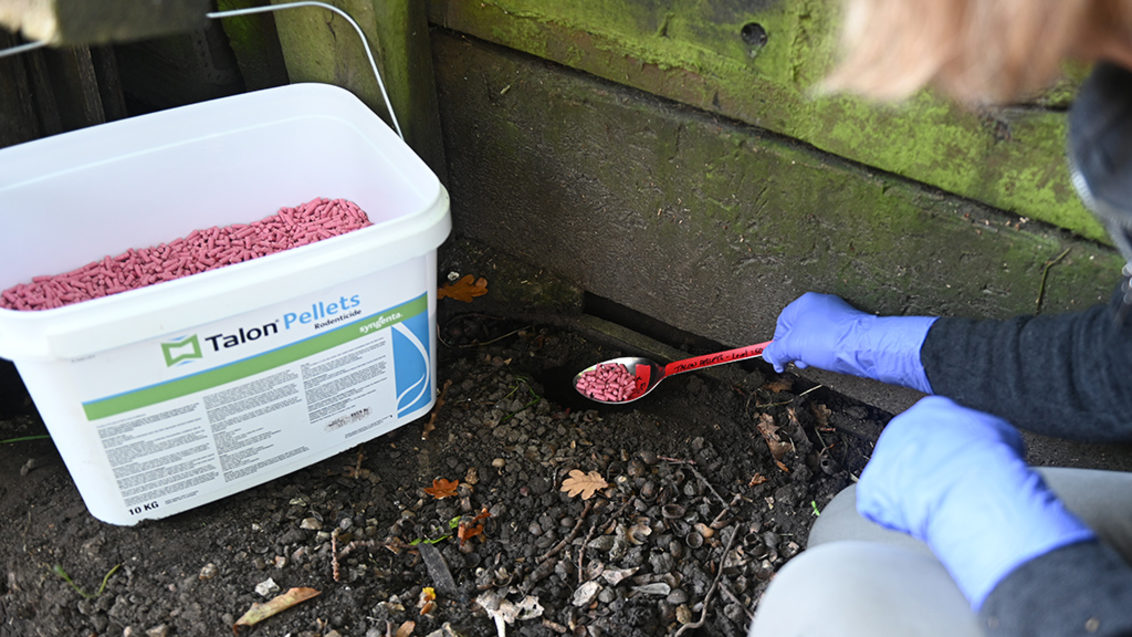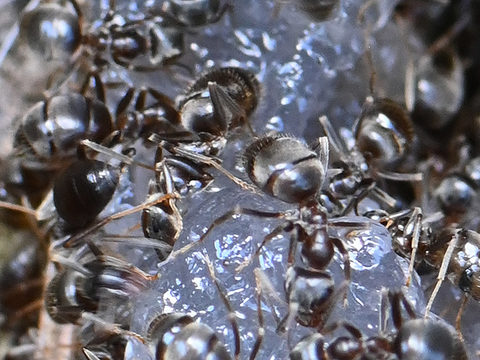Rat runs target with burrow baiting treatments

Rodenticide baiting still forms an essential component of today’s Integrated rat management programmes. While the emphasis is on environmental and physical controls, such as proofing and elimination of food sources, when rodenticides are required, then burrow baiting with Talon Pellets is typically the preferred technique.
Burrow baiting, where bait is applied directly into brown rat burrows, has two key advantages over baiting in boxes:
- Avoiding rats’ natural neophobia – if boxes are placed in their territory, it will take several days before they enter them, if they enter them at all. Burrow baiting avoids this neophobic reaction; the rats will usually readily consume bait placed in their burrow. So it is often possible to achieve faster control using burrow baiting.
- Bait placed into burrows is less accessible to non-targets than bait placed into bait boxes, so there is reduced risk of non-target poisoning.
Before implementing a rat control programme, carry out a thorough site survey to determine rat living and feeding areas along with the routes of travel between, advocates Syngenta Business Manager, Daniel Lightfoot. This will help decide on the appropriate control techniques for the site and where to place them.

An environmental risk assessment also needs to be completed, as required by CRRU (Campaign for Responsible Rodenticide Use). This is a statutory requirement, as adherence to the CRRU Code is now incorporated into label instructions. Ensure written records of the survey and the assessment are kept. These will help to follow the course of the control activities and demonstrate legal compliance.
Identifying active rat burrows
Burrows can be made directly down into a horizontal soil surface, but they are often made into banks or under paving slabs, sheds, debris or tree roots. Rat burrows have entrances of 6 to 9cm diameter, with spoil fanning out from them.

If there is no spoil, then it is likely that the tunnel was made outwards from a drain or sewer pipe. This would need to be checked carefully as it is important not to contaminate sewage or wastewater.
Ensure any burrows you are planning to treat are actually rat burrows, rather than being home to any non-target animals. For example, burrows of the highly-protected water vole can resemble rat burrows. The key differences are:
- Entrance hole size: water vole entrance holes are usually smaller in diameter than rat burrows (range 4 to 8cm)
- Vegetation around vole burrows is generally well-nibbled.
Note that water vole burrows are typically always found within three meters of running water, so if the burrow is a long way from water then it is more likely to be a rat burrow.
Prior to baiting any burrows, ensure they are active. Established active burrows will normally have at least one well-worn run extending from them. If the burrow is disused, then vegetation might have started growing over the run and there might be cobwebs or plant material in the burrow entrance. Note that rat burrows can have multiple entrances.
Bait selection
Bait placed in burrows can sometimes be ejected by the rats. For this reason, the formulation of bait used for burrow baiting needs to be selected carefully. A variety of formulations are approved for use in burrows, but some might be a better option than others.
For example, if blocks are used then whole blocks could be ejected. Whilst the blocks could be secured on a wire to help prevent them from being carried off whole, if they are left exposed on the soil surface then they are accessible for non-target animals to eat in situ.

Using loose grain or pellet bait overcomes this problem, since less of it is likely to be ejected. The bait is best not placed into polythene bags as this puts an unnecessary barrier, albeit a very thin one, between the rats and the food. In addition, the bags are more likely to be ejected due to them blocking the tunnel and being non-natural, and if they are ejected the extra quantity of bait in them means a bigger non-target hazard than loose bait.
All formulations will last several days in appetising condition for rats, even in a burrow with a high level of humidity. And as bait take in a burrow is likely to be relatively quick then longer-lasting moisture-resistant baits, such as wax blocks, are less desirable.
Loose grain or pellet baits are normally left in a burrow on completion of treatment, so it is best if they deteriorate and become unpalatable fairly quickly, so that they are not attractive to any other animals that might enter the burrow after the rats have died. The large surface area of these favoured finer formulations assists the breakdown process.
In order to minimise potential for non-target harm, as well as comply with COSHH, then the least toxic suitable product should be selected. So, in areas where there is no known or suspected resistance to any of the multi-feed anticoagulants, then these will need to be used.
However, where there is resistance, then products containing single-feed active ingredients will be needed. Talon Pellets are an ideal formulation for burrow baiting; it’s is highly palatable to rodents and contains the ‘single-feed’ active ingredient brodifacoum, making it an extremely effective product for burrow baiting. There is currently no known resistance to brodifacoum.
Check the label restrictions of the baits you intend to use for burrow baiting. Some can only be used ‘in and around buildings’ i.e. where the rats are actually entering buildings. If the rats are not physically entering buildings, then only baits approved for use in ‘open areas’ can be used.
Accurate application
Ensure anybody in the vicinity is warned about the rodenticide treatment.
The quantity of bait applied to each hole will depend on the number of burrow entrances you are baiting and how close together they are. Mark, or record the location of, any burrows you are treating so that you can locate them when you return for follow up visits.

Follow the application instructions written on the label of the product you are using. Bait labels specify the quantity that can be used per area, for example the Talon Pellets label specifies for rats: ‘20-50g of bait per baiting point every 10 metres (5 metres in high infestation areas)’. Thus, the maximum amount of Talon Pellets that can be applied, for example, is 50g every 5m in heavy infestations, so if there are lots of entrance holes close together you will need to leave some un-baited.
A common tool used for applying baits to burrows is a long-handled serving spoon. In order to be confident of using the correct dose, ensure you know how much your chosen applicator holds by determining and noting in advance the weight of bait it holds.

The bait needs to be placed as far into the hole as possible. The reason for this, is primarily to minimise the likelihood of rats ejecting it from the burrow, but it will also help to ensure optimum uptake. Where not all holes are being baited, then select the ones with the most vertical tunnels as this will also help prevent ejection.
Ensure you don’t block the tunnel with the bait – even if the rats are only feeding on your bait, they still need to be able to get out of the burrow to find drinking water. If bait is blocking the burrow, then they might clear a way through by ejecting some of it from the burrow.
After applying the bait, it is a label requirement that you backfill or cover the holes. The ideal thing to use is a handful of vegetation, such as grass, which can be lightly stuffed into the hole. If the hole is capped off too securely, the rats will make another exit. In so doing, they might either bury the bait or inadvertently eject it with the spoil, both of which are undesirable.

Using a grass bung will help to reduce the likelihood of bait being ejected from the burrow. And the rats can push it out of the way when they venture out to drink, so it will enable you to determine whether there is ongoing activity in the burrow.
Follow up measures
You need to return regularly to the site to search for and collect carcasses, remove any ejected bait and replenish burrows with fresh bait as required. Also, it is important to be comfortable that the environmental risk assessment still applies, or to update it as required.
It is good practice to return the next day after initial treatment to check that bait has not been ejected. Ideally, return early in the morning to minimise exposure of any ejected bait to non-targets. After this, follow up frequency will be determined by the technician, taking into account the local situation, the environmental risks and the toxicity of the product being used, along with the service level agreement with the customer. In some cases daily visits might be appropriate.
With the bait having been placed within the burrows, it is not possible to check how much has been consumed and how much has been hoarded for eating later. So you need to base replenishment rate on the estimated rat population. When using single feed baits such as Talon Pellets, then bait replenishment will not be required every visit – it should follow the pulse baiting principle of an initial 3-day interval, followed by 7-day intervals.

If multi-feed anticoagulants are being used and rat activity is ongoing, then suspect resistance, and consider switching to single feed anticoagulants, such as Talon Pellets.
Once activity has ceased, then on the final visit, the burrows should be backfilled and firmly sealed, to prevent entry by other non-target animals.








